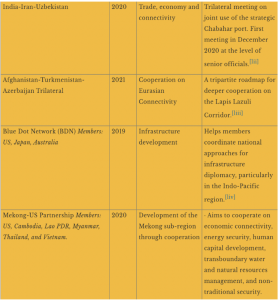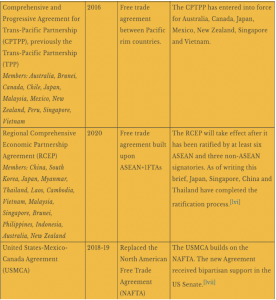Ques. What is minilateralism? Discuss its rise in security sphere of Indo-Pacific region and its implications.
Answer

- Minilateralism stems from the practice of multilateralism by breaking down complex issues into smaller ones before addressing them, an ode to Functionalism’s building from pieces strategy.
- Bhubhindar Singh and Sarah Teo argue that minilateral arrangements occupy the space between bilateralism (both the US- and China-led) and broader global multilateralism (such as the WTO, IMF, UN etc.), involving three to nine countries and are rather “exclusive, flexible and functional” in nature.
- Examples of minilateralism include groupings like SCO, CUSMA, RCEP, QUAD, AUKUS, Five Eyes Alliance etc. As institutional inertia and ‘great-power rivalry’ involving US, China and Russia heightens, it has impeded consensus- making in multilateral institutions. This has given rise, in recent years, to minilaterals especially in contested regions like Indo-Pacific.
- The rise of minilaterals is associated with stagnation in reforms, and the perceived failure of multilateral organisations to achieve global cooperation on the most pertinent issues facing the international community such as equitable trade, climate change, health emergencies etc.
- Moises Naim argues with failure of multilateralism, that one can have the “smallest possible number of countries needed to have the largest possible impact on solving a particular problem”.
- While minilaterals cannot replace multilaterals to achieve “true” global cooperation, they can supplement the work of multilateral organisations by providing a platform for diplomacy, confidence-building, and cooperation. Tirkey argues that Minilaterals allow a group of countries with shared interests and values to bypass seemingly moribund frameworks, and resolve issues of common concern.
Recent Examples of Minilaterals


Rise of Minilateralism for security in Indo-Pacific
- Changing geopolitical dynamics in Indo-Pacific including an assertive China, an insecure USA and growing fear among littoral countries, argues Rajagopalan, have produced new security arrangements in the form of minilaterals in the region.
- Return of balance in power politics is imperative for minilateralism to work in the Indo-Pacific. A disputatious China has driven India, and other countries in the Indo-Pacific to adopt a power-centric and pragmatic approach to moulding the regional order, like QUAD.
- Capacity constraints are another set of issues that have pushed minilateralism in the Indo-Pacific. All countries have had to deal with aggressive Chinese behaviour in their backyard while lacking in military and economic capacity.
- The decision-making process would also possibly move faster among like-minded networks, particularly in critical issues of national interest as maintaining a free and open Indo-Pacific has transformed into as well as improve interoperability considerably.
- However, there is a clear drawback to solely focusing on minilaterals as the only means for security cooperation in the Indo-Pacific. Most of the countries within the geographical construct of the Indo-Pacific are outside these exclusive groupings.
- Further, the rise of minilaterals in the Indo-Pacific can contradict and diminish the role of regional institutions such as ASEAN, ASEAN Regional Forum (ARF), and East Asia Summit.
- Sarah Teo argues that competitive politics of the region can further hinder the process of reconciliation and compromise in the Indo-Pacific, to the detriment of peace, prosperity, and stability in the region. Minilateralism could undermine multilateralism if, for instance, these “minilateral initiatives become platforms for major power rivalry.”
- According to William Tow, the rising phenomenon of minilateralism is not to be approached as “completely replacing existing alliances and institutions but as complementing them” to encourage some form of consensus and coordination amongst a small group of countries in an era of contested and fragmented international politics.
Click here to watch the video explanation of the above question.
Happy Learning!



